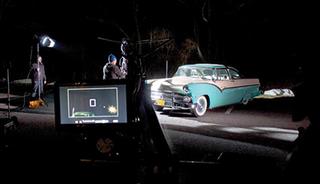The Magic of HMIs

Fig. 1: The author uses an 800-Watt Fresnel 20 feet camera left and a 200-Watt Fresnel 10 feet camera right to illuminate a 1955 Ford Crown Victoria so the jib could swoop down from the sky and could still show the occupant in the vehicle.
ALLENTOWN, PA.—One of the most versatile lights in existence, in my opinion, is the HMI. Hydrargyrum Medium-arc Iodide is the metal halide gas-filled lamp that provides a flicker-free, daylight-balanced light source for film or video shoots. Metal halides are mixed with mercury vapor in a quartz glass bulb. There are two tungsten electrodes of medium arc separation that ignite to provide illumination. Available in multiple wattages and in either Fresnel or PAR configuration, the HMI is utilized as a favored light source.
PAR OR FRSNEL?
Although they’re both HMIs, what is the difference between a Fresnel and a PAR? A Fresnel HMI is similar in make up to a tungsten Fresnel in that it utilizes a glass lens. Not to go into the history of the Frenchman inventor who bares the lens’ name, but much like a lighthouse lamp, the bulb’s light is diffused by the concentric rings on the glass lens in front of the light. The Fresnel has a sharp quality, even light that is often used as a direct source. Filmmakers often place an HMI Fresnel shooting through a window to simulate the sun’s rays. You also have the ability to spot or flood the light to decrease or increase the coverage with distinct shadow lines. Unfortunately, it doesn’t have the power or the punch of a PAR.
The Parabolic Aluminized Reflector or PAR HMI has a great output of light (I call it “punch”) with poorer quality. Much like an open faced light, the PAR is so powerful it is usually diffused or bounced unless it is used to simulate the sun or other extremely powerful source and has less of a defined shadow pattern. PARs often offer the ability to spot or flood.

Fig. 2: The author used two HMIs, a 200- and 800-Watt to shoot in a humid pool environment.
HOW THEY WORK
HMIs are four times as efficient because per watt, they exude 85–108 lumens of light. This is much more proficient than an incandescent unit. As mentioned earlier, HMIs are daylight- balanced in that their color temperature is rated between 5600 or 6000 degrees Kelvin. The color temperature can vary as the bulb ages with a much bluer temperature when first used, and as the electrodes in the lamp burn away, the color heads to the red side of the spectrum.
An HMI’s lamp cycles on and off up to 120 times per second. An incandescent lamp’s filaments do not cool down enough between this cycling, so this potential flickering is not a problem. Using a ballast, HMIs cycle this on/off frequency thousands of times faster so flicker is avoided. When a ballast is turned on, you hear a momentary “whoosh” because it ignites the arc in the lamp. Normally, you must wait a few moments until the lamp reaches its full brightness.
Within these ballasts are capacitors that store energy to enable the lights to consume less power. As the ballast hums, you know it is doing its job. The output of a 200 Watt HMI is equal to that of 750–1,000 Watt quartz light. The power consumption of a 200-Watt HMI is only 3 amps, compared to the 6.25 amps that a 750-Watt incandescent lamp draws. A 400- Watt HMI draws 5.5 amps and outputs the same amount of illumination as a 1,500/2,000- Watt incandescent lamp drawing 12.5 amps. You can determine other amperage draws by dividing the number of Watts by 120 (the number of volts in the United States). Math doesn’t lie; HMIs give more output using less power.
HMI DISADVANTAGES
HMIs are daylight balanced, which could be a deterrent if all of your other units are tungsten. You may gel the light, but you are lessening its output as well as diffusing it slightly.
Lamp life also is a determining factor, with some only lasting 200 hours. Replacement lamps are quite expensive. Newer HMIs are now offering “dimmability,” something that did not exist in the past. Also, a few manufacturers sell “water resistant” units that may be used in the rain. All in all, HMIs are expensive, but they do something that no other light does.
PUTTING THE HMI TO USE
Various manufacturers offer HMIs, but let’s focus on how specifically to use the lights rather than providing any endorsements.

Fig. 3: A 200-Watt Fresnel six feet behind and pointed at the subject’s head provided an extremely powerful backlight.
Outdoors in frigid weather, I needed to illuminate a 1955 Ford Crown Victoria so the jib could swoop down from the sky and we could still see the occupant in the vehicle (Fig 1). Using an 800-Watt Fresnel 20 feet camera left and a 200-Watt Fresnel 10 feet camera right (to light the man in the seat), I had the perfect lighting scenario at F4. HMIs always make whites pop, so the off white lacquer paint glowed as did the chrome. Still wanting the background to drop off dramatically, both of these units gave me a cool color temperature and both utilized a fifteen amp circuit.
Shooting in a humid pool environment, I again used two HMIs, a 200- and 800-Watt (Fig. 2). The 800 PAR with its stronger output, bounced off the water to provide reflections on the talent and raise the ambient light, while the 200 Fresnel provided a backlight to separate the “angel” from her background.
Sometimes, HMIs can be used closer to the talent for a dramatic effect. Although not shown in this article, when the talent revealed that she was a guardian angel, an HMI was the only way to boost the illuminate sufficiently to make her glow. Pointed at a bounce card, and at the appropriate time, the card was raised to provide the needed extra punch of light.
I was shooting indoors and wanted an extremely powerful backlight essentially making the angel’s hair look as if it were on fire. A 200-Watt Fresnel six feet behind and pointed at her head did the trick (Fig. 3). Because we were in such close quarters, that same HMI back/hair light was used as illumination for her face. With a white bounce card just below the camera, the extra light from the HMI provided the needed soft light for her face. Although window light provided a little fill, I still wanted more warm daylight on her face. Altering the color temperature and making the flesh tones warmer allowed me to achieve a daylight balance, with a warm glow on her olive skin.
HMIs are pretty much the only lights I use. With barn doors to direct the beam, flood or spot capability, the ability to make whites glow, and lower power consumption with more light output, all make the HMI an indispensible tool. And I haven’t even mentioned how it is a great light to use outdoors to simulate moonlight.
Chuck Gloman is chairman and associate professor of the TV/Film Department at DeSales University. He may be reachedchuck.gloman@desales.edu.
Get the TV Tech Newsletter
The professional video industry's #1 source for news, trends and product and tech information. Sign up below.
Chuck Gloman is Associate Professor with the TV/Film Department at DeSales University.

